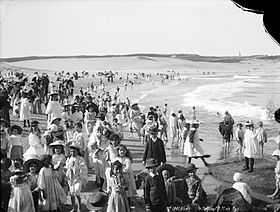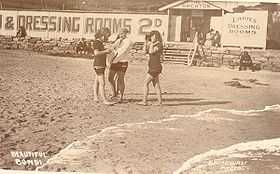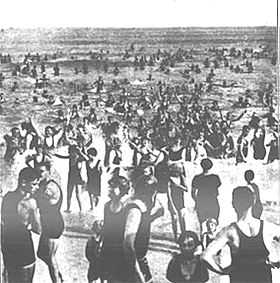Bondi Pavilion

The Bondi Surf Pavilion in Sydney, Australia, constructed in 1928, is a building of historic significance and has been listed by the Heritage Council.[1] According to the National Trust it "has come to represent the Australian culture of beach bathing and outdoors living".[2] The pavilion is managed by Waverley Council.
Background
In about 1900 there were no dressing sheds at Bondi, as bathing at that time was not a popular pastime. People went to the beach for a picnic, but they seldom went swimming.[3] However, from the beginning of the twentieth century the popularity of surf bathing began to grow. In 1905 Waverley Council agreed to the construction of two dressing sheds – one for men and one for women[4] (the ladies' shed is shown in the centre photo below) – although it soon became apparent that these sheds were not adequate, as they seem to have lacked roofs. One lady complained in 1910 that people passing in the tram could see those in the sheds dressing and undressing.[5] Consequently, new sheds were erected in 1911. These are pictured below (far right photo) and were described in detail in the Sydney Morning Herald:
Bondi now boasts not only the most up-to-date surf bathers' accommodation in the State but also the Commonwealth. It is provided with facilities for 1000 bathers and [the building] is divided into two sections providing accommodation for 750 men and 250 women. Bathers' compartments are separated by asbestos sheet partitioning and the floor is wholly of concrete to ensure cleanliness. Besides shower-baths and other necessities for bathers the front of the building is devoted to the purposes of a tea-room which is capable of holding a large number of persons while wide verandahs on the seaward side are also designed for tea parties.[6]
 |
 |
 |
| Bondi Beach circa 1900, before surf bathing became popular |
The ladies dressing sheds at Bondi, built about 1905 |
Bondi dressing sheds built in 1911 |
Construction
In 1923 Waverley Council commenced the implementation of the Bondi Beach and Park Improvement Scheme. The scheme included provision of a kiosk and surf sheds, three lavatory blocks, a band stand, parks to surround the buildings and increased car and pedestrian facilities. A competition was held to design the structures and was won by the architectural form of Robertson and Marks.[7]
The foundation stone marking the commencement of the project was laid in May 1928. In October the Sydney Morning Herald photographed the building, which was still under construction, as shown below.
 |
| Bondi Pavilion under construction in October 1928 |
The pavilion was a very ambitious project. It had extensive dressing cubicles, which were originally in two courtyards on the ground floor of the building. One courtyard was for men and the other for women, and the individual changing booths were constructed in rows in each courtyard.[8] These rows within the courtyards can be seen in the photograph above. It also had Turkish and hotwater baths, shops, a ballroom, cabaret theatre, an auditorium and a cafe. Tunnels leading from the two courtyards passed underneath Marine Parade (now Queen Elizabeth Drive) to a pair of concrete groynes which opened onto the beach.[9]
The pavilion was not officially opened until the end of 1929. However, by October 1928 the project was sufficiently completed to allow people to use the dressing accommodation. The council placed the advertisement shown below, outlining the attractions of Bondi.
 |
 |
| Newspaper advertisement outlining the attractions of Bondi Beach, October 1928 | Surf bathers at Bondi Beach, October 1928 |
Opening
The official opening of the Bondi Beach improvement scheme was held on 21 December 1929. The Sydney Morning Herald outlined the event in detail:
A great crowd attended the official opening of the Bondi Beach improvement scheme by the Mayor of Waverley (Alderman D Hunter) on Saturday afternoon. Bondi was permeated with music all through the day and evening. There were brass bands, fife and drum bands and bugle bands and when there was no band playing loud speakers took their place. A little after noon King Neptune landed from a surf boat in front of the pavilion where he was welcomed by the Mayoress. His majesty brought a number of balloons and these were eagerly struggled for by hundreds of children. The beach was alive with surfers and sea nymphs, Girl Guides and Boy Scouts and thousands of spectators. It was estimated that there were between 160,000 and 200,000 people present, the marine drive, promenade and the sands being covered by a dense mass of pleasure seekers.
A photo of some of the beach improvements is shown below. Some of the material commissioned by the council to promote Bondi is also shown.
 |
 |
 |
| Poster commissioned in 1929 by the council to promote Bondi |
Some of the beach improvements shortly before the official opening in December 1929 |
Booklet by the council promoting Bondi Beach |
Popularity
The Bondi Pavilion was well utilised for about two decades after its opening. During the war the first floor, where the Esplanade Cabaret had been, was requisitioned by the American Red Cross and the U.S. military to become an officers' club until the end of the war. After the war, dances were organised at the pavilion, and the proceeds went to disadvantaged Australian returned soldiers. In 1948 the pavilion obtained a liquor licence.[10]
Decline
By the mid-1950s utilisation of the pavilion had begun to decline, as changes in bathing costumes from heavy material to nylon reduced the need for changing rooms. In 1955 the council reported a substantial operating loss for the building. During the 1950s and 1960s the ground floor refreshment rooms were still in use and operated by lessees; however, the main hall and auditorium were rarely used. In an attempt to increase community participation, a theatre was opened in 1975 by Gough Whitlam. In 1977 and 1978 the changing rooms, lockers, former Turkish baths and courtyard were demolished. In their place a new netball court, an art gallery, a gymnasium and an amphitheatre were constructed. In 1978 the building was officially reopened as the Bondi Surf Pavilion Community Centre.[11]
Today
Today the pavilion is still a community centre. It has a theatre, a gallery and rehearsal, meeting and function rooms. Many cultural and film festivals are held at the building, and shops, changing rooms and toilets are still available to the public.
Endnotes
- ↑ Heritage Council, "Bondi Surf Pavilion" Online reference http://www.heritage.nsw.gov.au/07_subnav_01_2.cfm?itemid=2620255
- ↑ National Trust, News Release, 16 November 2007, Online reference http://www.nsw.nationaltrust.org.au/media/files/2007/november/media-16-11-07.pdf
- ↑ White, C. "Picnicing, Surf-Bathing and Middle-Class Morality on the Beach in the Eastern Suburbs of Sydney, 1811–1912", Journal of Australian Studies, No 80, 2004.
- ↑ Sydney Morning Herald, 22 August 1905, p. 9.
- ↑ Letter to the Editor, Sydney Morning Herald, 17 January 1910, p. 8.
- ↑ Sydney Morning Herald, 3 October 1911, p. 5.
- ↑ Heritage Council, "Bondi Beach Cultural Landscape" Online at http://www.heritage.nsw.gov.au/07_subnav_02_2.cfm?itemid=5055526
- ↑ Heritage Council, "Bondi Beach Cultural Landscape"
- ↑ Heritage Council, "Bondi Beach Cultural Landscape"
- ↑ Waverley City Council, "Bondi Pavilion: A Short History".
- ↑ Heritage Council, "Bondi Beach Cultural Landscape".
Coordinates: 33°53′25″S 151°16′38″E / 33.8902°S 151.2771°E